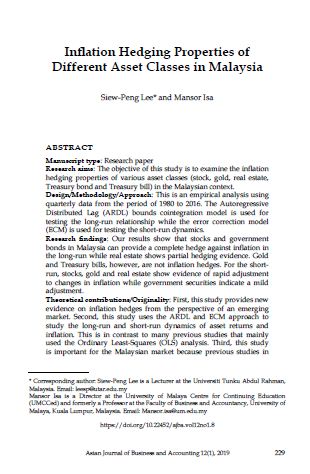Inflation Hedging Properties of Different Asset Classes in Malaysia
Main Article Content
Abstract
Manuscript type: Research paper
Research aims: The objective of this study is to examine the inflation hedging properties of various asset classes (stock, gold, real estate, Treasury bond and Treasury bill) in the Malaysian context.
Design/Methodology/Approach: This is an empirical analysis using quarterly data from the period of 1980 to 2016. The Autoregressive Distributed Lag (ARDL) bounds cointegration model is used for testing the long-run relationship while the error correction model (ECM) is used for testing the short-run dynamics.
Research findings: Our results show that stocks and government bonds in Malaysia can provide a complete hedge against inflation in the long-run while real estate shows partial hedging evidence. Gold and Treasury bills, however, are not inflation hedges. For the shortrun, stocks, gold and real estate show evidence of rapid adjustment to changes in inflation while government securities indicate a mild adjustment.
Theoretical contributions/Originality: First, this study provides new evidence on inflation hedges from the perspective of an emerging market. Second, this study uses the ARDL and ECM approach to study the long-run and short-run dynamics of asset returns and inflation. This is in contrast to many previous studies that mainly used the Ordinary Least-Squares (OLS) analysis. Third, this study is important for the Malaysian market because previous studies in Malaysia had merely focussed on stock returns and inflation. This study broadens the scope by including different asset classes.
Practitioner/Policy implications: The implication to investors and fund managers is that they should consider stocks, real estate and Treasury bonds in their investment portfolios, given that these asset returns offer satisfactory protection against inflation.
Research limitations/Implications: The result discussed in this study may be specific to the data and methodology employed in the analysis; thus, it is not applicable to other periods nor other emerging markets. Future studies on inflation hedges may consider a comparative study of a cross-section of countries or use an expanded array of assets in the analysis.
Keywords: Fisher Effect, Inflation Hedges, ARDL Bounds Tests, Malaysia
JEL Classification: G12, G18
